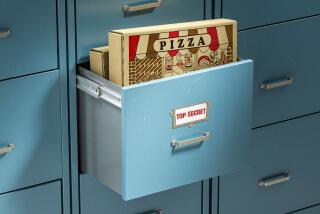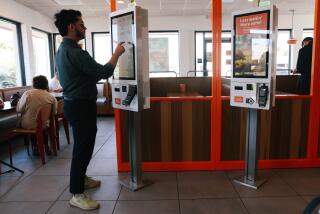Taking Meals Home
- Share via
It has probably happened to everyone who has ever ordered takeout food or had a pizza delivered. The carton leaks grease. The food is cold or stuck to the top of the box. A meal arrives in a jumble. What’s to become of takeout rack of lamb or filet mignon with mustard sauce? What’s a packaging manufacturer to do?
“The more complicated the gourmet meals get, and with presentation so important, the more difficult it is to package them properly,” said Joseph W. Bow, president of the Foodservice & Packaging Institute, a trade group in Washington. “We want them to arrive in a state that behooves the price tag these things have on them.” Unfortunately, Bow said, gourmet takeout and delivery businesses are proliferating “so quickly that it’s difficult for the industry to keep up. . . . There is quite a gap between what is needed in the gourmet food industry and what is out there and available, at any price.”
Another problem is that the packaging industry is used to making billions of a plastic foam container such as the ubiquitous fast-food hamburger “clam shell.” For a gourmet item, the manufacturer might need to make just a few thousand. And that means a costlier package: 25 to 50 cents versus the two to six cents for the mass-produced kind.
And then there’s the challenge of developing attractive containers that can be used in conventional or microwave ovens, Bow noted.
According to Find/SVP, a marketing research group in New York, the largest portion of the prepared takeout foods market in the year ended in August, 1987, was accounted for by restaurants (including fast-food outlets such as McDonald’s), with 64% of all takeout food sales, or $40 billion out of $62.4 billion. About 43.3% of all restaurant customers bought meals for consumption away from the premises.
Adding to the boom in gourmet takeout and delivery is, of all things, tax reform, according to Robert J. Nyman, president of George Lang Corp., a New York firm that is a consultant to the restaurant industry. Under new tax laws, only 80% of entertainment expenses such as restaurant lunches with clients can be written off. But in some cases if the company brings in food to the office for a seminar or meeting, Nyman said, it can be totally written off.
With Americans increasingly stating their preference for fresh, high-quality food, companies are trying to develop processes that will help restaurants and gourmet takeout establishments keep items fresh longer.
One emerging technology comes from France and has hit the U.S. food scene with not a small measure of controversy. Called sous vide (pronounced sue veed and translated from the French as “under vacuum”), the technology involves keeping food fresh in vacuum-sealed plastic pouches for several days until it is served. Specialty dishes such as poached salmon and chicken breast stuffed with feta cheese and spinach can be partially cooked, then reheated in boiling water or a steamer just before serving.
“The food quality is excellent,” said Joan Lang, executive editor of Restaurant Business magazine in New York.
Lang noted a major downside that will prompt many in the U.S. food industry to put sous vide on a back burner. The Food and Drug Administration recently issued a letter advising National Restaurant Assn. members that sous vide is “not acceptable in this country” and is “fraught with danger” because of the possibility of potentially life-threatening illnesses from improper processing or storage.
The takeout business clearly affords opportunities for entrepreneurs hungering for a fast food buck. At 7th Heaven in Santa Monica, the daily take has grown from $500 to about $3,000. The 800-square-foot store does $1 million a year.
As more takeout businesses sprout, about the only problem one industry consultant foresees is the potential for a shakeout. “Competition,” said Robert T. Patterson, a partner in the Los Angeles office of the Laventhol & Horwath accounting firm, “is fragmenting the market a little bit.”
But for now, he figures, “it appears that the pie will keep growing.”
More to Read
Eat your way across L.A.
Get our weekly Tasting Notes newsletter for reviews, news and more.
You may occasionally receive promotional content from the Los Angeles Times.










